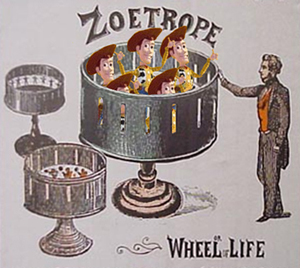


Comics are the print equivalent of animation, and you can find out more about them here.
Animation is as old as the drawings done on rock surfaces by cavemen that tried to capture the sequential movement of animals' legs as they ran. Over the centuries various mechanical devices, often sold as toys, replicated movement by running a series of still images in sequence — the earliest version of the zoetrope, which moved thanks to the hot air from a lamp, was invented in China around 180AD. It looks like the images are moving because of a phenomenon called persistence of vision. This was first proved in 1829 by the Belgian, Joseph Plateau, and his discoveries paved the way for a slew of nineteenth century inventions (the phenakistoscope, praxinoscope) that eventually gave us the Lumière Brothers' Cinematograph (the foundation of modern cinema) in 1895.
You can see some beautiful examples of early Phenakistiscope plates here.
While some early pioneers of film (like the Lumières) experimented with the new cinema technology to record real life events, others explored ways of creating fantasy narratives. Georges Méliès accidentally discovered stop motion animation when his camera broke down in the middle of filming one day, and he used the technique to make some of the earliest sci-fi movies. However, although he used animation techniques, he relied mainly on live action footage. J. Stuart Blackton adopted the principle of stop motion by drawing on a blackboard, and photographing the subtle changes in the drawings as he erased and redrew. Émile Cohl was the first to transfer his drawings to negative film, in 1908, which makes him the first person to produce a hand-drawn animated film.
Check out this site for the historical development of the art form. The Britannica entry also gives a useful overview.
If you want to get yourself up-to-date on current developments in animation (including some excellent links to current and forthcoming animated feature releases' websites) then have a look at Animation Artist, an online newsletter for those interested in Animation. You will also find some interesting articles at Animation Meat.
Animation is the process of linking a series of slightly different drawings together to simulate movement. There are normally 24 frames per second in moving film, and the best animation (ie the most flowing and detailed) will use a different drawing for each of those 24 frames. Limited animation will move to a new drawing less frequently, and this results in a jerky image.
The same processes used for film are used for the animated GIFs you see on websites.
There are three different types of animation:
| Cel Animation | Drawings are made on transparent sheets (celluloid) which may then be laid on top of each other to combine characters and backgrounds |
| Stop Motion Animation | A model or puppet (shadow puppets were used in early stop motion) is shot a frame at a time, with tiny changes in position being made between each frame |
| Computer animation | Computers can be used to entirely create the shapes and colours of animated action, working from a series of mathematical codes, or they can be used to enhance hand-drawn characters. Computer animation can be 2-D or 3-D. |
| Cel | Sheet of celluloid containing a single drawing. Opaque paints are used to create colour. Many different cels can be combined to create one frame |
| Inbetweening/Inbetweener | These are the drawings which link one key frame to another. Because they are a series of copies of the key drawing with only slight changes, they are drawn by Inbetweeners - animators who, although skilled, are still learning their trade. Some of this work has now been taken over by computers, but it is still an important role. For an online Inbetweening tutorial click here. |
| Key drawing/Key Animator | The main stages of movement, these frames are normally drawn by a more senior, experienced animator who needs to be more creative in producing them |
| Rostrum Camera | A large, one-frame-at-a-time movie camera which is mounted on a vertical column. Cels or other film images can be placed on a frame in front of it. These days it is generally controlled by a computer and can be programmed to move a precise distance up or down, in or out, and take several pictures of the same cel.There are also 3-D rostrum cameras. |
| Stretch and Squash | The technique invented by Disney animators in the early 1930s involving the exaggerated compression and extension of character body parts in order to create bouncy, humorous movement. |
For some online lessons in animation from a Disney-trained animator click here.